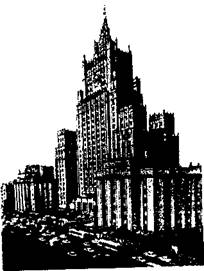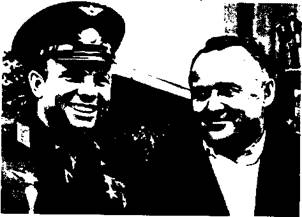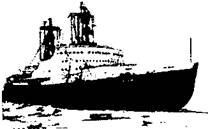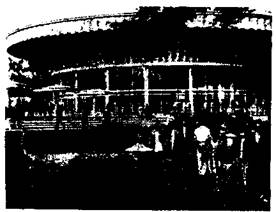home
 Economy Economy
 Books Books
 History of the world economy - Polyak GB History of the world economy - Polyak GB
|
History of the world economy - Polyak GB
34.3. Development of the economy of the USSR in the 50-80s
Post-war years in the history of the USSR can be described as a period of unprecedented rise, stagnation and crisis .

One of the first high-rise buildings in Moscow
The beginning of this upsurge can be considered the Great October Socialist Revolution, as a result of which the peoples of the vast country, tens of millions of previously disenfranchised people, having gained personal freedom, having achieved class and national equality, inspired by the idea of building a new society, began to recover with enthusiasm after the world and civil wars the economy of the country , Created a new intelligentsia, ensured the industrial power of the state.
The revolution, destroying class, class and national restrictions, made it possible to reveal the talents of the peoples who inhabited the country. The measures taken by the state in the field of education made it possible to prepare specialists for the branches of the national economy within a short period of time. Thousands of scientists, designers, tens of thousands of engineers, agronomists, doctors, educators emerged from the working, peasant and petty bourgeois environment, all peoples and nationalities of a multinational country.
Despite the difficulties of restoring the national economy, in the repression of the 1930s, the peoples of the USSR created in two decades the economic and industrial potential of the country, which enabled the state to survive in a deadly battle with German fascism. The joint struggle of all the republics of the USSR during the Great Patriotic War gave them hope for an improvement in life. The rapid restoration of the national economy after the war was to no small extent due to the psychological upsurge of the victorious nations, to the intellectual and industrial potential created in the pre-war years.
In the history of the USSR and Russia, the postwar years by the nature of socio-economic development can be divided into three periods:
• Take-off (1950-1970)
• stagnation (1971-1985)
• a crisis and a change in the socio-economic system (1985-1990).
Let's consider features of economic development of our country on these stages.
50th - 60th years
During these years the country's economy developed dynamically. For the first ten years, the average annual growth rate of gross industrial output amounted to 11.7%, gross agricultural output 5.0%, fixed production assets 9.9%, national income 10.2%, trade 11.4% .
This was facilitated by the renewal and modernization of fixed assets in industry, the strengthening of the material and technical base of agriculture, the expansion of the production of consumer goods, the development of virgin lands, and the improvement of the management system.
Considerable importance in the achieved successes had a change in the domestic political situation in the country. Death in 1953 I.V. Stalin was the beginning of the end of the totalitarian system that he had created and the beginning of the transition to a new course in domestic politics.
Elected to the post of First Secretary of the Central Committee of the CPSU NS. Khrushchev began to pursue a course connected with the social orientation of the economy, increasing capital investments in the B group and agriculture, and granting greater rights to the heads of enterprises and collective farms. Special attention was paid to the development of agriculture. The main emphasis was on the development of virgin and fallow lands. In Western Siberia and Kazakhstan, hundreds of new state farms, machine and tractor stations, roads were built, settlements were built. Naturally, this was an extensive way of development of the industry. But he allowed to achieve a five-year increase in agricultural production by 34%, to create in the East of the country new areas of agricultural production.
A major role in the complex development of regions and the regional economy was played by the transition in 1957 to territorial management principles. The overwhelming number of allied and republican ministries was abolished, and the enterprises were placed under the jurisdiction of the Soviets of Economic Development (Sovnarkhoz) established in the republics, regions and regions , whose formation was a definite step in decentralizing the management of the national economy, in expanding the rights and material capacities on the ground, in democratization Economy. At the same time, this created difficulties in the implementation of a single nationwide scientific and technical policy, dispersed resources, reduced the effect of the pre-existing benefit from the concentration of funds.
During these years, a significant step was taken to improve the standard of living of the population. This was reflected in the Law on Pensions, in the reduction of taxes, in the abolition of tuition fees in secondary schools and universities, in the introduction of a minimum guaranteed wage in agricultural production, in raising wages in other sectors, reducing the duration of the working week,
A special success was achieved in solving the housing problem. In the 1950s, preferential loans were granted to developers of individual houses. This has improved the situation with housing in small and medium-sized cities and rural areas. In the sixties, when designers and architects ensured the organization of a standard house-building on an industrial basis, the housing construction in the cities increased dramatically, allowing 80% of families in the cities to provide separate apartments by the end of the 1970s.
The level of public education has risen. The established network of schools, technical schools, universities allowed to form a good personnel potential of the country, which positively affected the development of science and culture. It is important to note that in the development of the economy of the USSR, 1950-1970. An important role was played by the factors of intensive growth, when the growth of the national income and of the gross social product was provided mainly by an increase in labor productivity and the introduction of achievements in scientific and technological progress. Industrial development was provided by a systematic increase in capital investments, in the structure of which the share allocated for expansion, reconstruction and technical re-equipment of operating enterprises increased.
During these years, technical innovations were widely introduced in the country's industry and transport. As you know, during the Second World War, the third scientific and technological revolution (STR) began, which is divided into two stages: 1945 - mid-60's. And the middle of the 60's - the end of the 80's. The leaders of the first stage of modern scientific and technological revolution were the USA and the USSR.
During these years, the Soviet Union made dramatic changes in technical development. Rapidly developing radioelectronic, nuclear, chemical industry, instrumentation. It was during these years that the country created its nuclear and missile capabilities, launched the world's first satellite, and then - a spaceship, the first manned flight into space, built the first nuclear power plants and marine nuclear ships. Thus, high rates of economic development were provided by an intensive type of extended reproduction.

Chief Designer of Spacecraft S.P. Korolyov and the first cosmonaut of the Earth Yu.A. Gagarin

The world's first Soviet artificial Earth satellite
In the period 1950-1970 gg. In the country, a radical restructuring of the fuel balance was carried out: the production of oil and gas increased, their share in the total energy resources increased three-fold - from 19.7 to 60.2%. To transport these valuable fuels, pipelines for long distances and the world's largest diameters with high throughput were built. Thanks to the network of pipelines connecting all the regions, with the exception of the Far East, a single maneuverable oil and gas supply system was created in the country .
Significant development was given to maritime transport, the tonnage of which the Soviet Union reached the fifth place in the world. The Soviet fleet was the youngest by age ships. This achievement of the scientific and technological revolution, like the invention of a jet and turboprop aircraft, has found wide application in our country - all aviation has been switched to jet engines, air lines have been serviced by high-speed aircraft, the USSR has dramatically expanded the network of international airlines. In these years, the technical reconstruction of railways - a transfer to electric and diesel traction. Since 1958, the production of locomotives has been stopped in the USSR. The development of road transport has developed, and the scale of road construction has increased. All this led to cardinal changes in the structure of the transport system - leading progressive vehicles became its leaders. The ownership of vehicles to the state ensured their interaction, the transport system was a unified state system.

The world's first nuclear icebreaker "Lenin"
Electric power industry developed at a high rate - the largest hydroelectric stations, thermal power stations were built; The construction of nuclear ones began. The creation of the Unified Energy System of the European part of the USSR was completed, including the Urals, the world's largest energy system.

The dam of the Bratsk Hydroelectric Power Station
For this period there is an intensive development of television, first black and white, from the 60's - color. The network of relay stations is expanding, due to which the scale of broadcasting increases, and an increasing number of regions and republics are involved in it. In 1970, the Ostankino television tower was commissioned.

Truskavets resort
The development of new areas and mineral deposits was on a large scale. The country was urbanized. The national wealth grew in the form of thousands of new enterprises, hundreds of new cities and towns.
The development of new lands, the construction of cities and enterprises created new jobs, which in turn provided a healthy socio-psychological climate in the state, confidence in obtaining work, housing, minimal domestic and socio-cultural goods and services, and confidence in the future.
The economic reform of the USSR contributed to the progressive development of the economy of 1965. It was expressed, on the one hand, in the centralization of the management of the national economy by the liquidation of economic councils and the re-creation of branch ministries. On the other hand, the self-supporting principle of economic management in enterprises was revived, funds for material incentives were created, fees for the basic production assets used by enterprises were introduced into the budget, enterprises were given broader rights in the field of planning, etc. All these activities were designed to increase the interest of labor collectives in The final results of production, the increase in the level of labor intensification and the economy of the country as a whole.
Already the first results of the reforms were positive. In the years 1966-1970. Rather high growth rates of basic economic indicators were achieved in the country. Science and industries, which determine scientific and technical progress (mechanical engineering, electronics, energy, petrochemical industry, etc.) developed rapidly. In terms of production of a number of types of industrial products, the USSR has overtaken the United States and occupied the first place in the world.
With the creation of the community of socialist countries, the international significance of the USSR, which stood at the head of the world socialist system, increased sharply. A lot of Third World countries adhered to socialist orientation. For the entire more than a thousand-year history of the Russian state, it did not have such a high economic potential, the standard of living of the population, international authority and influence on the destinies of the world.


Comments
When commenting on, remember that the content and tone of your message can hurt the feelings of real people, show respect and tolerance to your interlocutors even if you do not share their opinion, your behavior in the conditions of freedom of expression and anonymity provided by the Internet, changes Not only virtual, but also the real world. All comments are hidden from the index, spam is controlled.